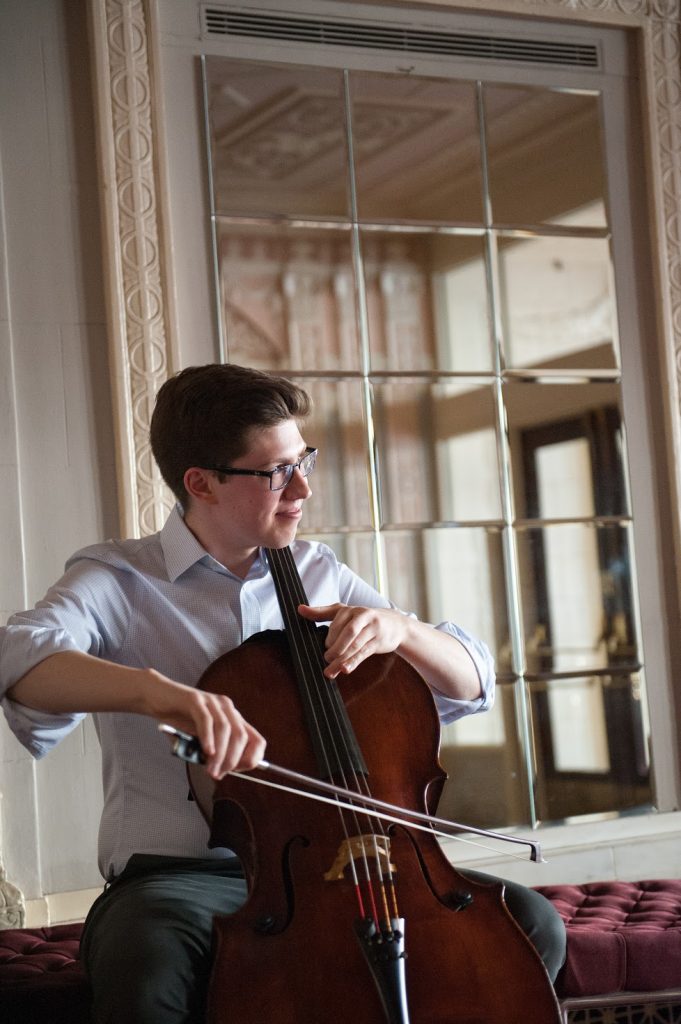Soloist Spotlight: Austin Huntington
This week, we are excited to welcome our own Austin Huntington to the stage as soloist for the Schumann Cello Concerto. No stranger to the spotlight, Austin has already performed in front of the orchestra this season for the Beethoven Triple Concerto in a “particularly striking” performance.

In anticipation of this week’s program, we sat down with Austin to discuss the differences between leading the cello section and soloing in front of the orchestra as well as his current instrument, on loan from Bein and Fushi while his own cello undergoes restoration:
Do you feel differently about your playing since you started in the orchestra in 2015?
While I’m sure my playing has changed over these five years, I have more been noticing an underlying awareness of what else is happening on stage in terms of what other instruments are doing and how the ensemble all fits together. I’ve always tried to pay attention to what is going on in other parts of the orchestra, but now it’s happening more instinctively and subconsciously, rather than purely based on knowing what is in the score.
Does it feel like a bigger challenge to play in front of the orchestra?
Playing in front of the orchestra is always incredibly challenging. Not only is it more difficult to perform the solo part, but it takes most people years to feel comfortable to be so exposed in front of a full orchestra and audience. When you are the soloist, you have that different role: you are always on top of the melodic food chain.
How different is it from leading your section?
In my mind, the main difference between solo and principal in the most basic form is whether you rely primarily on trust or collaboration. As a soloist, you generally shape your line and trust an unknown orchestra and conductor to support and follow you, whereas playing as a principal involves a much more collaborative approach, both with other musicians and the conductor.
Do you do any special preparation with the conductor before you step out on the stage for rehearsal as a soloist?
Before the first rehearsal with the orchestra, I will meet with the conductor to discuss tempos, transitions, and other more overarching musical ideas. This conversation never lasts too long as most of the subtleties will be communicated during rehearsal. Meeting first ensures that we are both on the same page for the first full rehearsal.
How does this differ from your preparation as a section principal?
As a section principal, there is almost no collaborative preparation with the conductor in advance of the first rehearsal. Most interactions, such as modifying a bowing or phrasing choice, happen during the rehearsals themselves.
Is there any advantage or disadvantage to soloing with an orchestra that you know well?
I think there are both advantages and challenges to soloing with an orchestra you know well. It is challenging because you know every musician on stage and hold a great deal of respect for them. I know I will feel pressure to perform for them!
That said, there is something rather reassuring about trusting the musicians on stage you work with every week, knowing that they respect the choices and musical decisions you make in performance!
So, tell us about this cello you have on loan!
I am so fortunate to be borrowing a cello made by Giuseppe ‘filius Andrea’ Guarneri of Cremona, Italy, circa 1715, on loan from Bein and Fushi. My personal cello is undergoing an extensive 10 month restoration right now, and Bein and Fushi was gracious to allow me to play on this instrument for both the Beethoven Triple Concerto and the Schumann Concerto. This is the kind of cello that cellists dream about playing some day, but because of the multi-million dollar price tag this particular instrument is out of reach of nearly every musician on earth. I cherish every moment with it. Every time I pick up this cello I have to pinch myself to make sure I’m not dreaming!